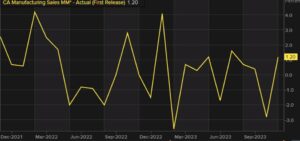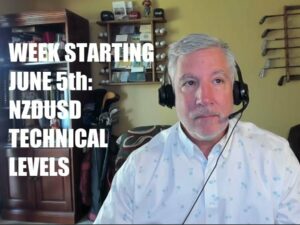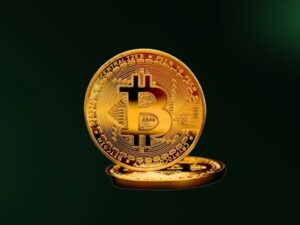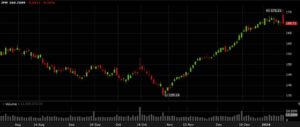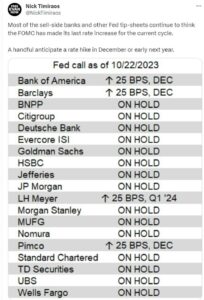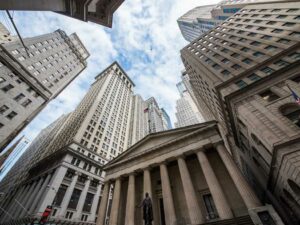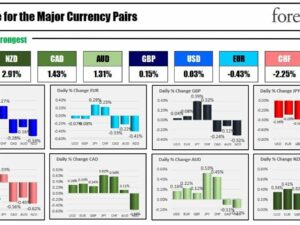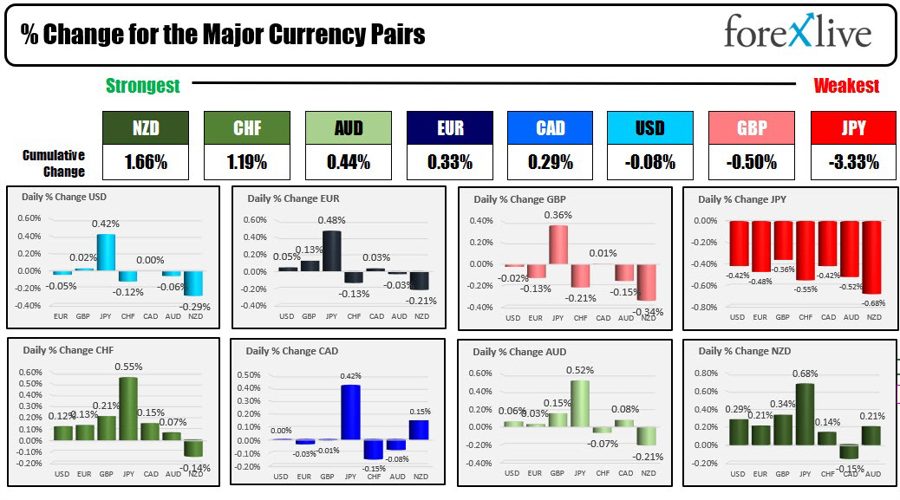
A gaggle of Fed speakers weighed in with comments today. Some had more to say than others. of the 5, Fed’s Bullad was the most hawkish. Others like Daly, Bostic and Barkin were more neutral and awaiting more data.
Below are the summaries of each:
- Thomas Barkin: Federal Reserve Bank of Richmond President Thomas Barkin refrained from prematurely forming an opinion on the outcome of the Federal Reserve’s June meeting. A critical area of his focus remains on inflation, and he is awaiting more evidence to be convinced that inflation is on a consistent downward trajectory. I would characterize his comments as being more neutral at this point.
- Rafael Bostic: Federal Reserve Bank of Atlanta President Raphael Bostic noted that the Fed has enacted a substantial amount of tightening over the past year and emphasized the need to avoid pushing the economy towards a slowdown. Bostic expressed his comfort in taking a patient approach to observe how the economy evolves before taking further action. His comments suggest a meeting-by-meeting approach, indicating a willingness to adapt and respond to changing economic circumstances rather than adhering to a predefined course.
- Mary Daly: San Francisco Federal Reserve President Mary Daly believes it’s wise to refrain from commenting on potential Fed policy actions and did not share her views on what the Fed should do at its June meeting. She expressed interest in observing how the policy tightening is impacting the economy. Daly reassured that despite the ongoing tightening, banks remain solid with stress levels appearing calm. She suggested that the Federal Reserve needs to be highly responsive to current conditions and stressed the importance of evaluating new data before the June FOMC meeting. Daly equated the effect of tighter credit conditions to one or two rate hikes and urged vigilance for signs of economic slowdown. She reassured that inflation expectations remain stable and supported the Fed’s meeting-by-meeting approach as prudent. She also noted that the global tightening cycle has had less impact on activity than expected and that the Federal Reserve balance sheet drawdown is functioning effectively. Despite observing some slowdown signs, she indicated that the job market remains generally strong. However, she cautioned that the Federal Reserve’s forecasts are as good as the data they were based on and pointed out that real wage growth for most Americans has been surpassed by inflation. She also acknowledged that credit troubles are rising for some Americans and believes that it wouldn’t be a historical anomaly to see 2% inflation with unemployment below 4%, but she did say that it seems reasonable for unemployment to rise above 4%.
- Neel Kashkari: Minneapolis Federal Reserve President Neel Kashkari made several critical comments regarding the current state of the U.S. economy. He noted that the decision to raise interest rates or pause in June was a close call, indicating some uncertainty in the Fed’s future policy direction. Kashkari expressed concern over inflation, mentioning that he saw no evidence of banking stress contributing to inflation
control, suggesting that the Fed needs to remain vigilant in its fight against rising prices. He also pointed out that inflation within the services sector appeared to be firmly established, which could indicate persistent upward price pressures. Furthermore, Kashkari hinted that the Federal Funds Rate might have to climb above 6% to effectively combat inflation, though he cautioned that such a move wasn’t yet clear. His comments reflect the ongoing challenges faced by the Fed in managing inflation in an uncertain economic environment. - James Bullard: St. Louis Fed President James Bullard made remarks suggesting a cautious outlook for the U.S. economy. He maintained his base case of relatively slow growth for the rest of the year and into 2024, while downplaying arguments of an impending recession as overstated. Bullard pointed out that the September median Fed funds target of 5.11% was based on expectations of slow growth and improvements in inflation that have not yet materialized. Consequently, he suggested that the Fed might need to raise the policy rate further, potentially by another 50 basis points this year from the current rate of 5.25%, to combat inflation. Bullard emphasized the need to fight inflation during a period of strong labor market conditions and noted that companies were still scrambling for workers, with job growth above trend. Despite stating that core measures of inflation have not changed much in recent months, he warned that if inflation isn’t controlled, the Fed would have to take more substantial action. He urged the Fed to err on the side of doing more, reflecting a sense of urgency in addressing inflation. Lastly, Bullard highlighted the decoupling from China as a significant issue for the U.S. and stated that he doesn’t anticipate changes to Quantitative Tightening (QT) anytime soon.
The comments did little to move a number of the major currencies. However, all the JPY pairs did see moves to the upside (lower JPY) today. The USDJPY moved by 0.41%. The NZDUSD moved the most with a gain of 0.68% on the day. The rest were in the range of 0.36% to 0.55% versus the closing levels.
The US was mixed with narrow trading ranges as traders await the results of the meeting with Biden and McCarthy scheduled for 5;30.PM ET. Meetings with staffers today were characterized as seeing a path to an agreement, but is not there yet.
Versus the month long averages,
- The EURUSD range was 36 pips versus a month average of 76 pips.
- The USDCAD range was 34 pips versus an average of 86 pips.
- The AUDUSD range was 40 pips versus an average of 63 pips.
- The NZDUSD range was 35 pips versus an average of 59 pips and
- The GBPUSD range was 59 pips versus an average of 90 pips.
The USDJPY was the only pair with an average trading range close to its month-long average. It had a range of 120 pips versus an average of 126 pips
The strongest to the weakest of the major currencies
A snapshot of the other markets near the end of day shows:
- Crude oil of $0.41 at $72.10
- Gold down $5.65 or -0.29% at 1971.63
- Silver down $0.23 or -0.99% at $23.60
- Bitcoin trade steady at $26,862
In the US debt market, yields were lower at the open but move higher after or hawkish comments from feds Bullard earlier in the day:
- 2 year yield 4.319% +3.1 basis points
- 5 year yield 3.763% +1.8 basis points
- 10 year yield 3.718% +2.7 basis points
- 30 year yield 3.966% +1.8 basis points
US stocks closed mixed seemingly under impacted by the ebbs and flows of the debt ceiling talks:
- Dow industrial average remained under more pressure with the decline of -140.05 points or -0.42% at 33286.59
- S&P index 0.63 points or 0.02% at 4192.62
- NASDAQ index 62.87 points or 0.50% at 12720.77
Thank you for your support and good fortune with your trading
- SEO Powered Content & PR Distribution. Get Amplified Today.
- PlatoAiStream. Web3 Data Intelligence. Knowledge Amplified. Access Here.
- Minting the Future w Adryenn Ashley. Access Here.
- Buy and Sell Shares in PRE-IPO Companies with PREIPO®. Access Here.
- Source: https://www.forexlive.com/news/forexlive-americas-fx-news-wrap-22-may-fed-official-weigh-in-as-markets-await-a-debt-deal-20230522/
- :has
- :is
- :not
- ][p
- 1
- 2%
- 2% Inflation
- 2024
- 22
- 23
- 26
- 30
- 40
- 50
- 7
- 8
- 87
- a
- above
- acknowledged
- Action
- actions
- activity
- adapt
- addressing
- After
- against
- Agreement
- All
- also
- Americans
- Americas
- amount
- an
- and
- Another
- anticipate
- appeared
- approach
- ARE
- AREA
- arguments
- AS
- At
- Atlanta
- average
- avoid
- await
- awaiting
- Balance
- Balance Sheet
- Bank
- Banking
- Banks
- base
- based
- basis
- BE
- been
- before
- being
- believes
- below
- biden
- but
- by
- call
- case
- cautious
- ceiling
- challenges
- changed
- Changes
- changing
- characterize
- characterized
- China
- circumstances
- clear
- climb
- Close
- closed
- closing
- combat
- comfort
- Commenting
- comments
- Companies
- Concern
- conditions
- Consequently
- consistent
- contributing
- control
- controlled
- Core
- could
- course
- credit
- critical
- currencies
- Current
- Current state
- cycle
- data
- day
- deal
- Debt
- decision
- Decline
- Despite
- DID
- direction
- do
- doing
- down
- downward
- during
- E&T
- each
- Earlier
- ebbs
- Economic
- economy
- effect
- effectively
- emphasized
- end
- Environment
- established
- EURUSD
- evaluating
- evidence
- evolves
- expectations
- expected
- expressed
- faced
- Fed
- Federal
- Federal Funds Rate
- federal reserve
- Federal Reserve Bank
- Feds
- fight
- firmly
- Flows
- Focus
- FOMC
- For
- forecasts
- Fortune
- Francisco
- from
- functioning
- funds
- further
- Furthermore
- future
- FX
- Gain
- generally
- Global
- good
- Growth
- had
- Have
- Hawkish
- he
- her
- higher
- Highlighted
- highly
- Hikes
- his
- historical
- How
- However
- HTTPS
- i
- if
- Impact
- impacted
- impacting
- impending
- importance
- improvements
- in
- index
- indicate
- indicated
- indicating
- industrial
- inflation
- Inflation expectations
- interest
- Interest Rates
- into
- isn
- issue
- IT
- ITS
- Job
- jpg
- JPY
- june
- labor
- labor market
- less
- levels
- like
- little
- Long
- Louis
- made
- major
- managing
- Market
- market conditions
- Markets
- May..
- measures
- meeting
- meetings
- might
- mixed
- Month
- months
- more
- most
- move
- moves
- much
- Near
- Need
- needs
- Neel Kashkari
- Neutral
- New
- news
- no
- noted
- number
- observe
- of
- official
- Oil
- on
- ONE
- ongoing
- only
- open
- Opinion
- or
- Other
- Others
- out
- Outcome
- Outlook
- over
- pair
- pairs
- past
- path
- patient
- pause
- period
- plato
- Plato Data Intelligence
- PlatoData
- Point
- points
- policy
- potential
- potentially
- president
- pressure
- price
- Prices
- Pushing
- QT
- quantitative
- quantitative tightening
- raise
- range
- Rate
- rate hikes
- Rates
- rather
- real
- reasonable
- recent
- recession
- reflect
- regarding
- relatively
- remain
- remained
- remains
- Reserve
- reserve bank
- Respond
- responsive
- REST
- Results
- Rise
- rising
- s
- San
- San Francisco
- say
- scheduled
- sector
- see
- seeing
- seems
- sense
- Sense of Urgency
- September
- Services
- several
- Share
- she
- sheet
- should
- Shows
- side
- significant
- Signs
- slow
- Slowdown
- Snapshot
- solid
- some
- Soon
- speakers
- stable
- State
- stated
- steady
- Still
- Stocks
- stress
- strong
- substantial
- such
- suggest
- support
- Supported
- surpassed
- Take
- taking
- Talks
- Target
- than
- that
- The
- the Fed
- There.
- they
- this
- this year
- though?
- tightening
- tighter
- to
- today
- towards
- trade
- Traders
- Trading
- trajectory
- Trend
- two
- u.s.
- U.S. economy
- Uncertain
- Uncertainty
- under
- unemployment
- Upside
- upward
- urgency
- us
- US Debt
- Versus
- views
- wage
- was
- wasn
- weigh
- were
- What
- which
- while
- Willingness
- WISE
- with
- within
- workers
- would
- wrap
- year
- yet
- Yield
- yields
- you
- Your
- zephyrnet


